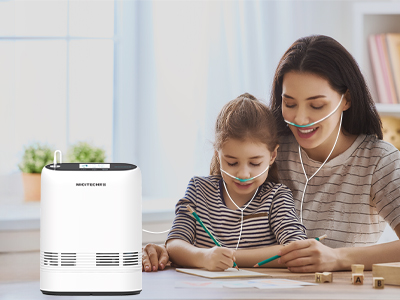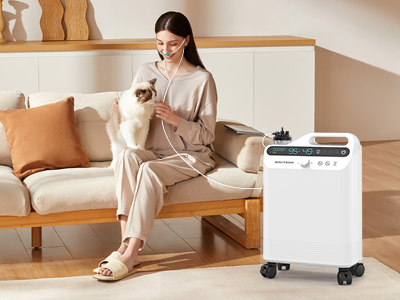24 Jun 2024
Chronic Obstructive Pulmonary Disease (COPD) and other lung diseases are pervasive health issues affecting millions globally. These conditions impede normal breathing, significantly impacting quality of life. Oxygen therapy emerges as a vital treatment option, providing relief and enhancing life quality.
Oxygen therapy ensuring adequate oxygen levels in the bloodstream, it alleviates symptoms, improves physical activity tolerance, and enhances overall well-being.

Understanding COPD and Lung Diseases
A. Definition and Types
COPD encompasses a group of lung conditions that obstruct airflow and make breathing difficult. The two primary types are chronic bronchitis and emphysema. Other significant lung diseases include pulmonary fibrosis and interstitial lung disease, which also hinder respiratory function.
B. Causes and Risk Factors
The leading cause of COPD is long-term exposure to irritants that damage the lungs and airways, with cigarette smoke being the most prevalent. Other risk factors include air pollution, chemical fumes, and a history of respiratory infections.
The Role of Oxygen Therapy
A. How Oxygen Therapy Works
Oxygen therapy involves delivering supplemental oxygen to patients whose blood oxygen levels are too low. It works by increasing the amount of oxygen that flows into the lungs and, consequently, the bloodstream, which helps alleviate symptoms of breathlessness and fatigue.
B. Benefits of Oxygen Therapy
The benefits are manifold: improved energy levels, enhanced sleep quality, better mental clarity, and increased stamina for physical activities. For those with severe lung diseases, oxygen therapy can also prolong life.
Types of Oxygen Therapy
A. Continuous Flow Oxygen
This type provides a constant flow of oxygen, which is essential for patients needing consistent oxygen levels throughout the day and night.
B. Pulse Dose Oxygen
Pulse dose systems deliver oxygen in pulses, usually synchronized with the patient’s breathing pattern. This method is often used to conserve oxygen and is suitable for patients with less severe oxygen needs.
C. Portable Oxygen Concentrators
Portable devices allow patients to move freely without being tethered to a stationary oxygen source. These concentrators are lightweight and can be used during travel, offering a significant improvement in mobility and independence.

Indications for Oxygen Therapy
A. Symptoms Indicating the Need
Symptoms that may indicate the need for oxygen therapy include persistent shortness of breath, rapid heartbeat, frequent respiratory infections, and cyanosis (bluish tint to the skin).
B. Diagnostic Criteria
Doctors typically use arterial blood gas (ABG) tests and pulse oximetry to determine the need for oxygen therapy. These tests measure the levels of oxygen and carbon dioxide in the blood.
Administration Methods
A. Nasal Cannula
A nasal cannula is a lightweight tube with two prongs that fit into the nostrils. It’s commonly used for its simplicity and comfort.
B. Oxygen Masks
Oxygen masks cover the nose and mouth and can deliver higher concentrations of oxygen. They are often used in more severe cases or during acute respiratory distress.
C. Transtracheal Oxygen Therapy
This method involves a small catheter inserted directly into the trachea, offering a direct and efficient way to deliver oxygen, often used when other methods are insufficient.
Potential Complications and Side Effects
A. Common Side Effects
While oxygen therapy is generally safe, common side effects include nasal dryness or bleeding, skin irritation from the cannula or mask, and sometimes headaches.
B. Managing Complications
It’s crucial to manage these complications with appropriate measures such as using humidifiers, ensuring proper fit of the device, and regular monitoring by healthcare providers.
Lifestyle and Management
A. Integrating Oxygen Therapy into Daily Life
Patients should create a comfortable environment for using oxygen therapy at home, including designated areas for equipment and ensuring easy access to oxygen supplies.
B. Tips for Traveling with Oxygen
Traveling with oxygen requires planning. Patients should check with airlines for specific regulations, carry a portable concentrator, and have a doctor's note.
C. Exercise and Physical Activity
Regular physical activity, tailored to individual capabilities, can significantly improve lung function and overall health. Oxygen therapy can make exercise more manageable by reducing breathlessness.
Technological Advances in Oxygen Therapy
A. Innovations in Equipment
Recent innovations include more compact and efficient portable oxygen concentrators, smart devices that adjust oxygen delivery based on real-time needs, and improved battery life for longer usage.
B. Future Trends
The future of oxygen therapy lies in continued technological advancements, making devices more user-friendly, efficient, and integrated with digital health platforms for better patient management.
Conclusion
For patients and caregivers, embracing oxygen therapy can transform lives. Staying informed, proactive, and engaged with healthcare providers ensures the best outcomes in managing these challenging conditions.
Keywords: oxygen therapy
Originally published 24 Jun 2024, updated 24 Jun 2024.